SIU Annual Report 2017
Contents:
- Director's Message
- SIU Presence at Major Conferences
- Investing in Education
- Communications
- Outreach
- Affected Persons
- Vision, Mission, Values
- Training
- Cases at a Glance
- Charge: 17-TVI-004
- Charge: 17-OCI-071
- Closure Memo: 17-OCD-275
- Non-Charge: 17-PVI-024
- Non-Charge: 17-PCI-124
- Non-Charge: 17-OVI-062
- Non-Charge: 17-OFD-135
- Statistically Speaking
- Cases opened by the SIU
- How the SIU is Notified
- Cases Closed by the SIU
- Information about Complainants
- Investigative Response
- Appendix A: 2017 Case Breakdown by County, Police Service and Population
- 2017–2018 Financials
- SIU Organization Chart
Director's Message

This has been a particularly busy and turbulent year in the life of this important institution, and as such, I must begin by recognizing the incredible efforts of all SIU staff, and in particular the frontline investigators whose work is at the very heart of the SIU’s mandate to conduct independent investigations of serious injuries, sexual assault complaints and deaths in cases involving the police. With our caseload approaching record-high levels, and ever increasing in legal and technical complexity, the Unit’s investigators yet again acquitted themselves impeccably in meeting their daily challenges to ensure SIU investigations continued to be defined by professionalism and fairness. I offer them my sincere thanks for a job very well done, as I do to the other members of the SIU team who, though often less visible, are no less important to our success. That we are able to continuously rely on cutting-edge training to all staff to ensure our skills remain sharp, communication and outreach services to Ontario’s many communities so that the public’s confidence in our work remains strong, legal advice designed to keep our investigations unassailable, decision-making that benefits from the wise deployment of resources and quality-controls, and the business support services that bring everything together, is a testament to the SIU’s training, public engagement, legal, management and administrative professionals. By the time they have brought their expertise to bear on a file, what is left for me to do is very little. And for that, I am thankful.
I wish also to recognize the release of the Report of the Independent Police Oversight Review in March 2017, representing the culmination of the work of the Honourable Michael H. Tulloch and his team, appointed in 2016 by the Ontario government to examine ways to make the province’s system of police accountability more transparent, accountable and effective. I take this opportunity to formally commend Justice Tulloch for his public service in putting together a thoughtful report that, I am certain, will map the course of civilian oversight of the police for the next quarter century. Recommendations contained in the report to reconstitute the SIU as a fully independent agency of government under its own governing legislation, coupled with suggestions for additional SIU powers to ensure that the Unit’s investigations are more efficient and effective, will go a long way to promoting the integrity and independence of SIU investigations well into the future. In addition, of significant importance are the recommendations aimed at ensuring SIU operations are at all times culturally sensitive having regard to Ontario’s Indigenous and culturally diverse communities, and open and accessible to the extent possible so that Ontarians of all stripes can understand and appreciate the important work of the office. After all, the SIU exists to serve the public. In this, I am satisfied that the report’s recommendations have struck an appropriate balance between the need to publicize more information and the importance to the investigative process of maintaining confidential certain information. I am even more heartened with indications that the recommendations regarding the SIU will be implemented in legislation as soon as possible.
In closing, it is an honour to be here as the Director of the SIU as a new chapter in its history begins. From its fledgling beginnings in 1990, the office has grown to become a well-respected institution known the world over for the work that it does and, with that, Ontario has rightly gained a reputation as a leader in the civilian oversight of police. It is appropriate on such an occasion to recognize the many people who have staffed the SIU’s offices over the years and their tireless work in making the SIU what it is today, and I do so now with a tip of my hat. On behalf of the fine women and men of today’s SIU, I also commit this office to meeting the challenges of a new day, and I look forward with great anticipation to leading the SIU through 2018 and working with all stakeholders to strengthen and build on the progress we have achieved together.
SIU Presence at Major Conferences
Canadian Association for Civilian Oversight of Law Enforcement
The annual Canadian Association for Civilian Oversight of Law Enforcement (CACOLE) conference was held in St. John’s, Newfoundland and Labrador from May 29-31, 2017. The conference – titled Perspectives from the Inside Out – was attended by approximately 130 delegates from across Canada, and some individuals from abroad. The delegates included individuals from civilian oversight, community groups, law enforcement and academia. CACOLE is a national non-profit organization of individuals and agencies involved in the oversight of police officers in Canada. Both SIU Director Tony Loparco and SIU Communications Coordinator Monica Hudon attended the conference. Ms. Hudon was a panellist for a session titled ‘Public Interest and Public Engagement through Social Media: What, How and Whether’. The panellists discussed the various ways their respective organizations utilized social media to not only assist with investigations, but to also keep the public informed and engaged. With respect to the SIU, Ms. Hudon spoke of the SIU’s Twitter and YouTube accounts, the newly created informational video series and changes to the website to allow the public to upload videos taken of incidents under investigation by the SIU.
While in the province, Director Loparco and leaders from some of the other oversight agencies met with the Minister of Justice and Public Safety, the Honourable Andrew Parsons for a discussion about the pros and cons of creating an oversight agency for Newfoundland and Labrador alone, or for the Atlantic provinces as a whole.

Group photo of participants at 2017 CACOLE conference
National Association for Civilian Oversight of Law Enforcement
The 23rd annual National Association for Civilian Oversight of Law Enforcement (NACOLE) conference – titled Civilian Oversight in a Changing Landscape – was held from September 10-14, 2017 in Spokane, Washington. NACOLE is a non-profit organization in the United States that works to enhance accountability and transparency in policing and build community trust through civilian oversight.SIU Director Loparco was invited to the conference to sit on a panel titled, ‘Conducting Criminal Investigations of Police Uses of Force’. This session involved a discussion of the “independent investigation agency” model of police oversight and how it has been applied to improve public confidence in the police throughout Canada as well as how it could – and from the point of view of the panellists, should – be applied in the U.S. context. The panellists discussed the different potential models, the challenges faced in implementing and sustaining successful programs, and the ultimate benefits of the police no longer policing themselves.
The program agenda pointed out that although there are 17 civilian oversight programs worldwide that conduct independent criminal investigations of police-related critical incidents (with 6 of those programs located in Canada), this type of oversight mechanism does not currently exist in the United States.
Following the conference, a letter from the NACOLE Board of Directors was sent to Director Loparco:
“Specifically, we would like to thank you for your excellent presentation on the work that you do in Canada surrounding criminal investigations of police use of force. Your willingness to share your knowledge and insight was of great benefit to our attendees.”
Consular Corps Association of Toronto
On February 14, 2017, Director Loparco was the keynote speaker for an event organized by the Consular Corps Association of Toronto (CCAT). The CCAT is comprised of more than 100 missions currently in Toronto. At this particular luncheon, more than 35 representatives from different countries were in attendance. Director Loparco spoke about the rule of law in Canada, the creation of the SIU, and how having a body similar to the SIU worked to enhance police accountability and community confidence in policing. He touched on the review by Justice Tulloch and the need to maintain the privacy of those involved in SIU investigations. Director Loparco said an SIU-type model not only had a role in Ontario, but could be adapted on a global scale. He touched on some of the recent visitors to the SIU from other countries, as well as requests from other countries that the SIU attend conferences internationally. The keynote speech was followed by questions from several in the audience.
After the event, George Oprea – the treasurer of CCAT and the Honorary Consul of Moldova to Ontario – wrote:
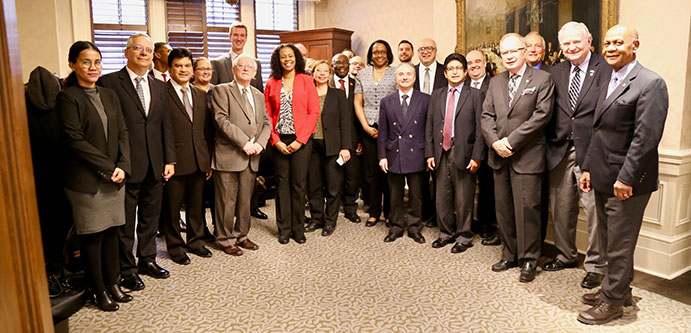
SIU Director Tony Loparco with members of Consular Corps Association of Toronto
Urban Alliance on Race Relations
On March 21, 2017, Director Loparco, Executive Officer William Curtis and Legal Counsel Joseph Martino attended Toronto’s City Hall for a public forum organized by the Urban Alliance on Race Relations. The keynote of the forum – a panel discussion titled ‘Unite to Stop Hate’ – brought a selection of speakers together to reflect on the history of racism in Ontario and the continuing challenges faced by racialized persons in the province. The Urban Alliance on Race Relations was at the forefront of calls for the establishment of the SIU in 1990 and has throughout its history pressed for the importance of police accountability and civilian oversight. Then, as now, the SIU affirms its commitment to a constructive relationship with the Urban Alliance on Race Relations.
Anti-Racism Directorate
On December 1, 2017, Director Loparco attended the Anti-Racism Directorate’s inaugural anti-racism conference at Exhibition Place in Toronto. Moving Forward: Challenging Power and Privilege through Anti-Racism Leadership brought together anti-racism experts, community partners, policy makers and government leaders for a day of discussions on advancing anti-racism work. More than 300 people attended the one-day conference.Investing in Education
Take Our Kids to Work
The SIU’s Take Our Kids to Work day is held annually and helps grade 9 students to explore and plan for future careers through a practical workplace experience. This year, the SIU welcomed 12 students – some related to SIU staff and some from neighborhood schools - to the Unit on Wednesday, November 1, 2017. The students participated in a mock SIU investigation, and through the full day experience, they learned about numerous aspects of SIU investigations including intake, note taking and interviewing. Part of the day was also dedicated to learning about the forensic aspects of SIU investigations and students processed a “scene” in the SIU parking lot. Students learned about scene photography, fingerprint lifting and evidence collection. To complete the day, the students met with Director Tony Loparco and presented the findings of their investigation.
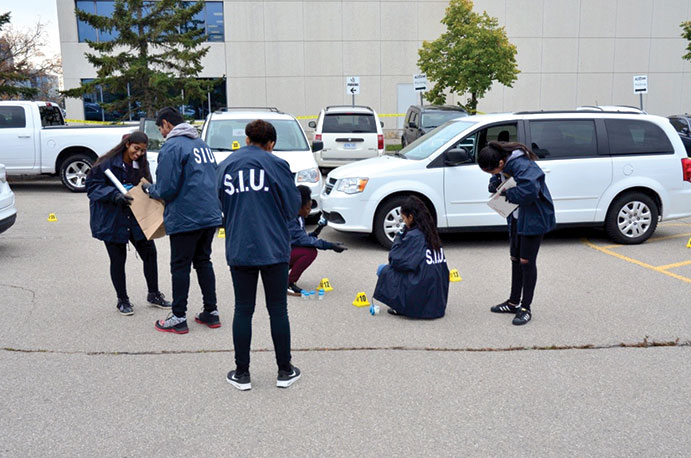
Students collecting evidence at the scene

Students end the day with a photo with SIU Director Loparco and SIU staff
Student Program
During the fall and winter months, the SIU engages in various cooperative student placements to give youth a chance to work in their field of study. The SIU connects with various colleges and universities to accommodate these placements during the year. In addition, the SIU has summer student and summer law student work placements between April and August. Although the types of assignments given to students vary from year to year, some examples of experience gained at the SIU include:- Data collection,
- Legal research and memos,
- Assistance with SIU’s case management system,
- Attending court,
- Attending training sessions,
- P.E.A.C.E. investigative interviewing,
- Learning about investigative processes and forensic investigations,
- Investigation exercise (mock interview, follow-up report and Director’s Report),
- Observing investigations, and
- Attending Outreach sessions.
The SIU is proud of its student program, and is thoroughly impressed with the caliber of students who have come through the program. In addition to learning much from the SIU, the SIU has enjoyed the fresh perspectives offered by the students.
PROFILE: Bianca Caputo, Summer Student
 As a student in the Justice Studies program at the University of Guelph-Humber, I had learned so much about the Special Investigations Unit over the years but could never imagine having the opportunity of actually being a part of this agency. Throughout the summer of 2017, my learning experience has not only been administrative, but about the process of SIU investigations as a whole.
As a student in the Justice Studies program at the University of Guelph-Humber, I had learned so much about the Special Investigations Unit over the years but could never imagine having the opportunity of actually being a part of this agency. Throughout the summer of 2017, my learning experience has not only been administrative, but about the process of SIU investigations as a whole.My role at the SIU varied from reception duties, to assisting with administrative tasks, to corresponding with various police services via letters regarding investigations. During my time at the SIU, I was able to compile research regarding police accountability and interference within investigations which was definitely a beneficial learning experience for my future endeavours. I’ve had opportunities to learn from the investigators about their day-to-day work and even tag along to call-outs and other field work which was definitely an exciting occurrence. I want to thank the Director, managers, investigators, counsel and administrative staff who have made my experience at the SIU one I am very thankful for. I hope to work with you in the field one day!
PROFILE: Nicole Smith, Summer Student
My time at the Special Investigations Unit began in September 2016, as a co-op student as part of my degree in Forensic Psychology. I researched Mental Illness, Violence and Use of Force data and studied the advantages of the P.E.A.C.E investigative interviewing method. I returned to the SIU as a Summer Student in 2017. I attended investigator training seminars and participated in relevant discussions relating to Justice Tulloch’s review of civilian police oversight agencies.
I was able to engage with experienced individuals working in a variety of different positions - investigators, forensic investigators, lawyers, administrative, and communications staff - who were all working towards a common goal at the SIU, and who were all essential to its operation.
I was given the unique opportunity of working in different positions and saw all the work that goes on behind the scenes that one might not think of when you imagine a typical investigations unit that the media has portrayed.
Being at the SIU was a great opportunity to gain valuable experience in my field of interest and create new professional connections that will aid my future endeavours. Thank you for a remarkable experience.
Communications
SIU Responds to 950+ Inquiries
Communication with the media is important in ensuring that the SIU remains responsive, transparent and accountable to the public it serves. Because the SIU takes on cases at all hours of the day across the province, SIU Communications has made it a priority to respond to media 24 hours a day, 7 days a week.From January 1, 2017 to December 31, 2017, SIU Communications responded to 960 inquiries from media via phone, email, text, Twitter and in-person. Approximately 330 of those responses were after-hours. The nature of the questions varied, with media looking for the following types of information:
- Updates on SIU cases,
- Statistics, and
- Backgrounder information to get a better understanding of SIU policies and procedures.
While the vast majority of calls were from media across Ontario, we also responded to other media reaching out to us from across the country, as well as international media.
Using Video to Answer Frequently Asked Questions
To supplement the Unit’s current communications and outreach efforts to enhance publicunderstanding of the SIU, the SIU launched a series of short videos –produced in-house – that set out to provide Ontarians with quick, informative answers to frequently asked questions about the Unit’s mandate, jurisdiction and investigative process. While all of this information can be found on the SIU’s website, the videos are another means of relaying that information in a manner many have found to be fast and convenient.
The videos – which can be found on the SIU website (https://www.siu.on.ca/en/siu_videos.php) and on the SIU’s YouTube channel – each received several hundreds of views, with the first video getting in excess of 1,200 views. News of the video series was covered by several media outlets. Videos were produced on the following topics:
- An Overview of the SIU
- SIU Notification Process
- Going to the Scene
- SIU Investigators
- The Evidence
- Balancing Transparency with Investigative Needs
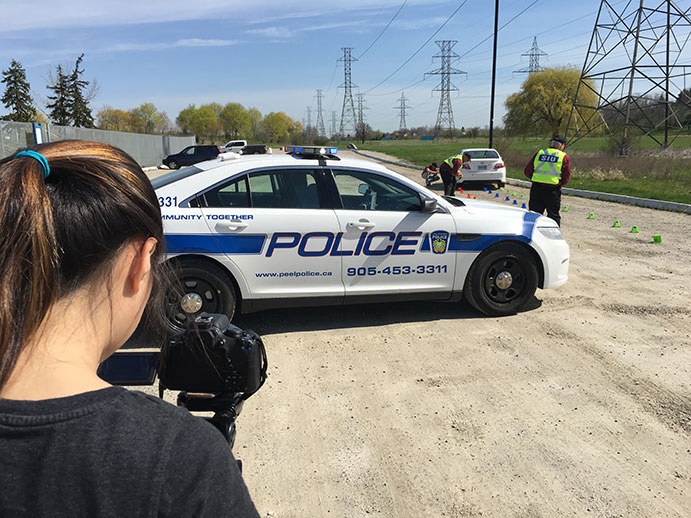
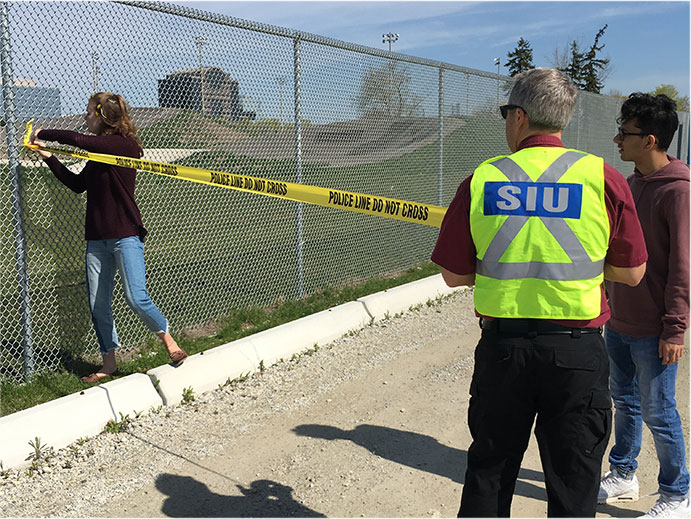
More News Releases
The SIU is notified of hundreds of incidents every year. Given the SIU’s present resources, it is not feasible to issue news releases each time the SIU launches an investigation. The SIU is committed to issuing news releases in death cases, whenever a firearm causes serious injury, and for major vehicle collisions. Here is a breakdown of the 279 news releases the SIU issued in 2017: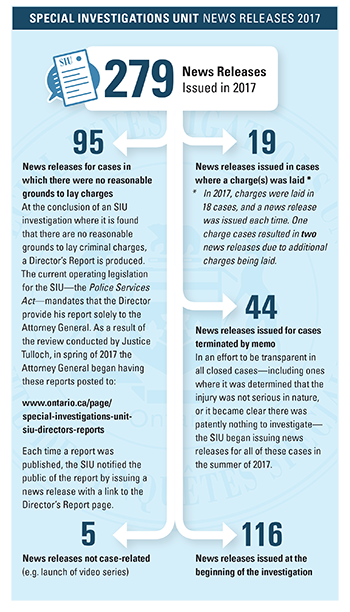
Outreach
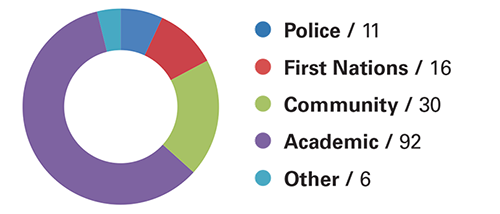
Reaching New Canadians
Every year, Ontario welcomes tens of thousands of new immigrants. Many of these new Canadians travelled from parts of the world where policing standards are not as rigorous as the standards in this province. In many of these countries, civilian oversight of police does not exist.As a way to educate new Canadians, the Special Investigations Unit has partnered with Malton Neighbourhood Services (MNS) to create a module for use in Language Instruction for Newcomers to Canada (LINC) programs across the province.
LINC classes help those new to Canada learn English. The classes also assist with integration and settlement.
The module that MNS is creating with the SIU includes a pre-lesson plan, a presentation by the SIU, and a post-lesson plan, giving teachers a three-day module that they can incorporate into their curriculum.
The hope is that many more new Canadians can understand police accountability and have confidence in police services in Ontario.
Partnering With Toronto Public Library
 Close to a third of the cases that the SIU handles occur in Toronto. This, coupled with extensive media coverage in the provincial capital, has resulted in intense public interest in how the Unit operates.
Close to a third of the cases that the SIU handles occur in Toronto. This, coupled with extensive media coverage in the provincial capital, has resulted in intense public interest in how the Unit operates.In an effort to provide Torontonians with more information about the SIU's processes and activities, the Unit's Outreach team approached the Toronto Public Library (TPL).
Working closely with the TPL senior staff, a series of presentations was developed, with some of the following themes:
- Dispelling the Myths of the SIU
- The Science Behind SIU Investigations
- What is the Special Investigations Unit? A Course for Newcomers to Ontario
In 2018, the Unit is scheduled to make 23 presentations at 17 branches across the city.
Affected Persons
The Affected Persons Program is an integral component of the SIU, providing support services to those negatively impacted by incidents investigated by the Unit. The program strives to respond to the psychosocial needs of affected persons by offering immediate crisis support, information, guidance, advocacy and referrals to community agencies. The Affected Persons Coordinator (APC) is available to respond to the needs of affected persons 24 hours a day, 7 days a week. Throughout 2017, the Affected Persons Program was involved in 95 cases.
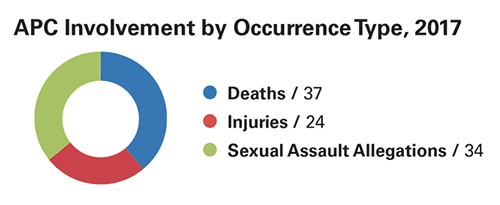
The establishment and maintenance of relationships with government and community partner agencies across the province is a crucial element of the ongoing effectiveness of the program. These efforts continued throughout 2017, in coordination with Victim Service Units, Victim Witness Assistance Programs, and the Office of the Chief Coroner.
Formally established in 2014, the Affected Persons Court Support Program continues to provide direct services to SIU complainants and witnesses throughout the court process, which is often difficult and confusing.
Of the 18 cases in which charges were laid in 2017, the Affected Persons Program provided court support services in 12 of the cases (67%).

Vision, Mission, Values
OUR VISIONThe essence of the SIU is our conviction and belief in our role demonstrated by all.
- We are always striving for understanding of SIU by community and police throughout Ontario.
- We strive for stability through shared leadership and individual empowerment in a continually changing environment.
- We believe in open, respectful communication in all directions to promote common understanding.
- We inspire excellence through teamwork.
- We invest where it matters… in our talent, tools and training.
- We are committed to being a great place to work.
OUR MISSION
- We are a skilled team of civilians dedicated to serving Ontario’s diverse communities.
- We conduct thorough and unbiased investigations where someone is seriously injured, alleges sexual assault or dies when involved with the police.
- Our independence in seeking and assessing all the evidence ensures police accountability, inspiring the confidence of all in the work of the SIU.
OUR VALUES
Training
In 2017, the Unit welcomed 11 new investigators and one forensic investigator during two recruitment drives. Of the 12 new hires, five had civilian backgrounds, while seven had prior police experience. All new investigators spent approximately 130 hours at Unit headquarters during their onboarding, prior to being partnered with an investigator for the next six months through the Unit’s New Investigator Coaching Program.
Over the course of the year, Unit staff completed approximately 4,500 hours of learning and development initiatives. Training was delivered via in-house seminars, external conference and course attendance and through online tutorials, both externally and through the Ontario Public Service (OPS). The Unit’s forensic investigators and collision reconstructionists also attended technical training through their professional organizations. Here are some of the learning and development opportunities SIU investigators took part in:
- Canadian Police Knowledge Network,
- The Ontario Police College,
- Osgoode Hall Law School Professional Development,
- Frances Glessner Lee Homicide Seminar,
- Canadian Association of Technical Accident Investigators and Reconstructionists,
- Toronto Police Service 26th Forensic Training Conference, and
- The Institute for Management Studies.
Additionally, each year the Unit facilitates three ‘Investigators’ Training Seminars’ which are attended by all investigative and forensic investigators as well as the operational managers. Topics include emerging issues, Peer Case Reviews, and technically-based presentations delivered by subject matter experts (Centre of Forensic Sciences, etc.). OPS vendors and professionals are also invited to facilitate soft-skills training.
In addition to supporting the ongoing learning and development needs of Unit staff, the Special Investigations Unit completed a number of initiatives aimed at increasing the staff’s collective cultural competency during the 2017 calendar year. This was accomplished in part by having staff from the Native Canadian Centre of Toronto (NCCT) facilitate a half-day presentation on First Nations Awareness. All investigative staff also viewed the Alanis Obomsawin documentary ‘Trick or Treaty,’ which delves into the history of Treaty 9, the 1905 agreement between the First Nations and the Canadian government. Additional efforts to support this important learning and development initiative saw all Unit staff attend a half-day session on Bias-Awareness training.
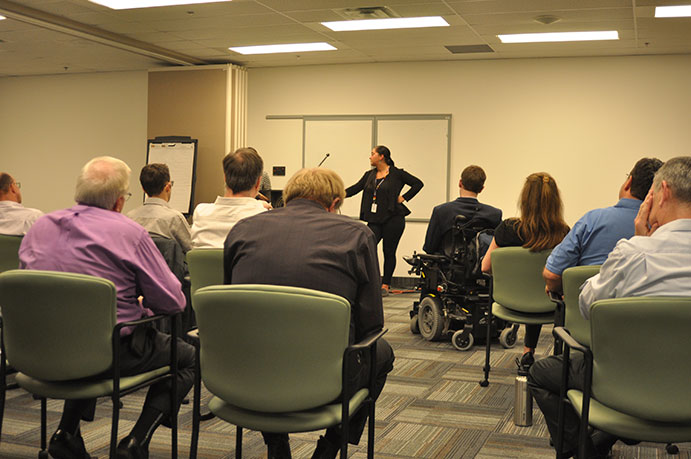
Cases at a Glance
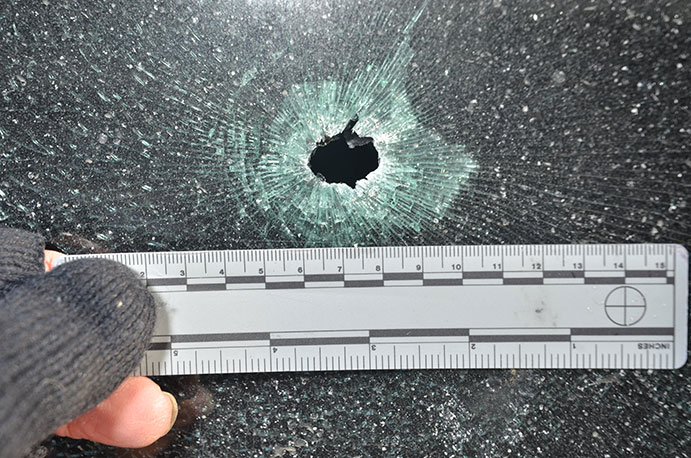
Charge: 17-TVI-004
Incident Overview
In the evening hours of, January 9, 2017, Toronto Police Service officers responded to the area of McCowan Road and Lawrence Avenue East and located a 52-year-old man riding a bicycle. A police cruiser being driven by the subject officer collided with the man’s bicycle, and the man was transported to hospital for treatment of serious injuries.The Investigation
The SIU assigned four investigators, one forensic investigator and one collision reconstructionist to examine the circumstances surrounding this incident. As part of the investigation, the SIU interviewed the 52-year-old man, two civilian witnesses and eight witness officers. The subject officer consented to an interview with the SIU and he provided a copy of his duty notes. The SIU conducted a collision reconstruction of the scene, and examined the police cruiser and the man’s bike.
The SIU reviewed the following:
- In-car camera system recordings from police cruisers,
- Automated Vehicle Locator data from subject officer’s cruiser, and
- Call and radio transmission recordings.
The Director’s Decision
Based on the evidence and information collected in relation to this incident, SIU Director Tony Loparco concluded there were reasonable grounds to believe a Toronto Police Service constable committed a criminal offence. As a result, on June 27, 2017, the subject officer was charged with dangerous driving causing bodily harm, contrary to s. 249(3) of the Criminal Code.The Prosecution
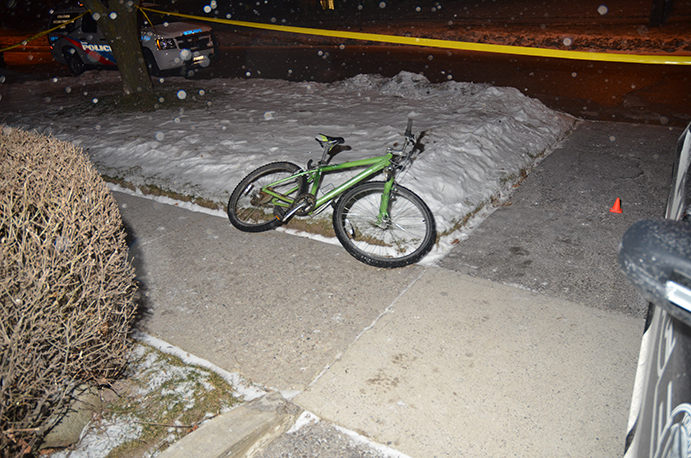
17-TVI-004 / Collision scene
Charge: 17-OCI-071
Incident Overview
On the night of April 5, 2017, York Regional Police officers were investigating a complaint in the area of Glenwoods Avenue and The Queensway South in Keswick. The subject officer became involved in an interaction with a 30-year-old man, and the man was arrested. The following morning, the man was diagnosed with a serious injury.The Investigation
The SIU assigned four investigators and one forensic investigator to examine the circumstances surrounding this incident. As part of the investigation, the SIU interviewed the 30-year-old man, eight civilian witnesses and seven witness officers. The subject officer did consent to an interview with the SIU, but he did not provide a copy of his duty notes, as is his legal right.
The Unit reviewed evidence including:
- Radio communications,
- In-car camera footage from the police cruisers, and
- Police station video.
From the police service, the SIU obtained a detailed call history, general occurrence report, training record for the subject officer and various police procedure documents.
The Director’s Decision
Based on the evidence and information collected in relation to this incident, SIU Director Tony Loparco concluded there were reasonable grounds to believe a York Regional Police constable committed a criminal offence. As a result, on September 8, 2017, the subject officer was charged with assault causing bodily harm, contrary to s. 267(b) of the Criminal Code.The Prosecution

17-OCI-071 / Photo of area of altercation
Closure Memo: 17-OCD-275
Incident Overview
At approximately 2:20 p.m. on Monday, September 25, 2017, members from the Niagara Regional Police Service (NRPS) and from the Niagara Parks Police Service (NPPS) responded to the Niagara Parkway as a result of a call. Upon arrival, a 46-year-old man was located hanging onto the railing above the Niagara Gorge. While one NPPS special constable commenced communicating with the man, the other NPPS special constables and NRPS officers assisted with the perimeter by clearing both vehicle and pedestrian traffic in the area. A short time later, the man let go of the railing and fell to his death.The Investigation
The SIU assigned two investigators and one forensic investigator to probe the circumstances of this incident. As part of the investigation, two civilian witnesses were interviewed – one individual who knew the deceased, and one who was a member of the NPPS and involved in the incident.
As part of the investigation, the SIU obtained and reviewed the memo of understanding between the NRPS Board and NPPS.
The Director’s Decision
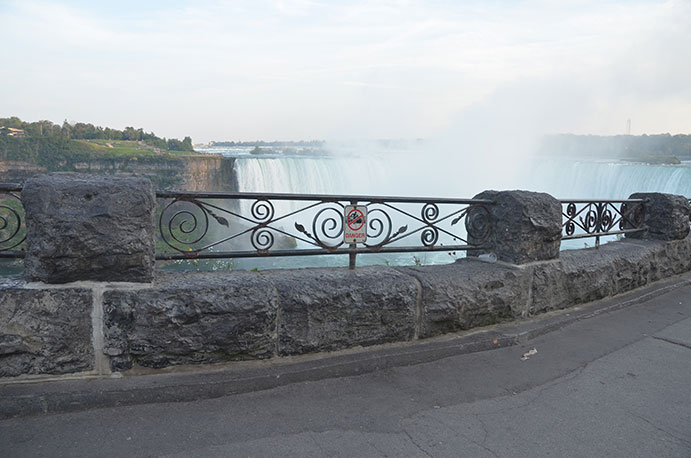
17-OOD-275 / Railing above Niagara Gorge
Non-Charge: 17-PVI-024
The full report for this investigation can be found at https://www.ontario.ca/page/siu-directors-report-case-17-pvi-024. The report includes details on the evidence collected, as well as the full analysis of the investigation.Incident Narrative
On January 28, 2017, just before 1:56 p.m., a 66-year-old man was operating his GMC pick¬up truck and towing a closed trailer on Highway 401 west of Sweaburg Road in Oxford County. He was observed by the subject officer (SO), who was operating an unmarked Ontario Provincial Police (OPP) cruiser. The SO pulled the man over for failing to have the proper annual inspection sticker affixed to his trailer. The man pulled to the right shoulder of Highway 401, and the SO got out of his cruiser and spoke to the man through his passenger window. The SO advised the man about the inspection requirements for his trailer, and issued him a warning. The SO returned to his police cruiser and left his roof lights activated while he stayed parked behind the truck, waiting for the man to re-enter the flow of traffic.When the man's vehicle had not moved, the SO approached the vehicle a second time. The SO observed the man to be lying on his back on the ground under the vehicle with his upper body under the left side of the truck and his lower body extended toward the roadway. The man's head was pinched between the front left wheel and the ground and he was blue in colour.
The SO attempted to pull the man out from under the truck, but was unable to do so. The SO entered the truck and tried to shift the vehicle into drive to move it off of the man, but found that the gear shift would not engage.
The SO radioed for an ambulance and police assistance. Another officer immediately responded and got into the truck while the SO attempted to push both the truck and trailer with his police cruiser. The man’s truck eventually moved forward enough that he was pulled free. CPR was administered until paramedics arrived. The man was subsequently transported to the hospital where he was diagnosed with eight fractured ribs, likely secondary to the administration of CPR, and a pneumothorax (collapsed lung).
The Investigation
The SIU assigned three investigators and two forensic investigators to probe the circumstances of this incident. The SIU interviewed the man and obtained and reviewed his medical records. Eight civilian witnesses and one witness officer were interviewed. The subject officer participated in an SIU interview and provided a copy of his duty notes.
As part of the SIU’s investigation, the man’s vehicle was examined and communications recordings were reviewed.
The SIU obtained and reviewed the following materials and documents from the OPP Ingersoll Satellite Office (Oxford) and the London Highway Safety Division:
- Event Details,
- Notes from the witness officer,
- Occurrence Details,
- Occurrence Report,
- Property Report, and
- Supplementary Occurrence Reports.
Director's Decision (Summary from Director’s Report)
An examination conducted of the man's truck after the fact confirmed that the transmission cable had been separated from the transmission linkage arm, and from the collection of dirt and debris, it appeared that the linkage had been in this condition for some time. The defect was not uncommon and could occur over time thereby preventing the driver from engaging any gear from the gear lever inside the vehicle; the gears could, however, still be engaged manually from the underside of the vehicle. Similar to engaging the gear using the lever inside of the vehicle, when the gears are manually engaged, they cycle through the various gears from "Park" to "Reverse" to "Neutral" to "Drive", in that order.On a review of all of the evidence, it appears clear that after the SO stopped the man and then returned to his cruiser, the man was unable to re-engage the gear shift in order to continue driving his vehicle. As such, he turned and locked the wheels to the right to allow him better access to the underside of his vehicle, and then got under the truck to try and engage the gears manually. In doing so, he engaged the "Reverse" gear first, and without a second person inside the truck depressing the brake pedal, the truck reversed over the man and then came to a stop, pinning the man's head under the wheel, thereby stopping the continuous movement of the truck.
It is obvious in these circumstances that the injury to the man was caused by his own actions and without intervention by any police officers. In fact, had the man attempted to carry out this manoeuver in the absence of the SO, he would likely have died. It was the quick thinking of the SO in calling for assistance and in then removing the deadly pressure from the man’s head, as well as the diligence and perseverance of those who stopped to assist, in continuing lifesaving techniques when it appeared that the man might already be dead, that ultimately saved his life.
On that basis, it seems trite to say that there are no reasonable grounds to believe that any criminal offence has been committed by any officer involved with the man. In the final analysis, there is no basis for the laying of criminal charges.
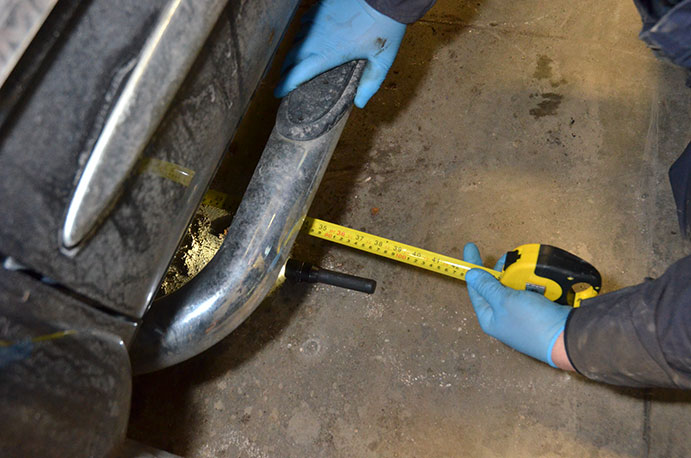
17-PVI-024 / Forensic investigators examining pickup truck
Non-Charge: 17-PCI-124
The full report for this investigation can be found at https://www.ontario.ca/page/siu-directors-report-case-17-pci-124. The report includes details on the evidence collected, as well as the full analysis of the investigation.Incident Narrative
On April 6, 2017, Ontario Provincial Police (OPP) officers went to a wooded area in Sioux Lookout after receiving information that there were intoxicated persons at that location. Subject officer #1 (SO #1) arrived and saw a 45-year-old woman asleep on the ground in an intoxicated condition. She was arrested and handcuffed by SO #1. Subject officer #2 (SO #2) assisted SO #1 in walking the woman to a police vehicle. The woman was cooperative when taken to the Sioux Lookout OPP Detachment, searched and lodged. The woman was unsteady on her feet and fell to the floor while being searched.Three days later, the woman had her wrist examined and she was diagnosed with having sustained a distal radial fracture.
The Investigation
The SIU assigned three investigators to probe the circumstances of this incident. The SIU interviewed the woman and obtained and reviewed her medical records. Unfortunately, the woman could not assist the investigation as she advised that she had no recollection of her interaction with police on the date in question. SIU investigators reviewed notes from six witness officers, and found it necessary to interview two of those officers. One police employee witness was interviewed. While SO #1 participated in an SIU interview and provided a copy of his duty notes, SO #2 declined to be interviewed and did not provide his notes, as is the subject officer’s legal right. No civilian witnesses to this interaction came forward to speak with investigators, nor could they be located.
As part of the SIU’s investigation, OPP video was reviewed.
Upon request, the SIU obtained and reviewed the following materials and documents from the OPP:
- Civilian witness information,
- Duty Roster,
- Event Details Report,
- Incident History for the woman,
- Involved officer list,
- Notes of witness officers, and
- Written Statement of one witness officer.
Director's Decision (Summary from Director’s Report)
Pursuant to s. 25(1) of the Criminal Code, police officers are restricted in their use of force to that which is reasonably necessary in the execution of a lawful duty. Turning first to the lawfulness of the arrest and apprehension of the woman, the officers had reasonable grounds to believe she was intoxicated in a public place and she could be arrested under the Liquor Licence Act. Additionally, it was cold outside, there was snow on the ground, the woman was passed out or asleep on the ground and appeared to be in such a state of intoxication as to be unable to care for herself, and there was a basis for real concern that if she was left where she was found, she would come to some harm. Having made these observations, there was a duty on the police officers to assist the woman and remove her from harm’s way whether she was cooperative or not, and to take her to a place of safety until she was able to care for herself. As such, the arrest and apprehension of the woman was legally justified in the circumstances.With respect to the amount of force used by SO #1 and SO #2 in their attempts to arrest and escort the woman to the police cruiser and then on to the police detachment, I find that their actions consisted of an extremely minimal amount of force being applied and certainly not of such a degree as to attract criminal sanctions. In light of the fact that the woman was actively resisting by digging in her heels, yelling, screaming, and flailing her legs, I have no doubt that it would have been easier for the police officers to simply abandon their efforts to assist the woman and to leave her behind in the cold, but they were duty bound to remove her from harm’s way and they did so with the minimum amount of force required for that purpose.
Similarly, the officer who searched the woman before she was lodged in the cells in order to ensure that she was not in possession of anything that could harm herself or others, only applied the minimum amount of force to do so. The woman fell to the floor as a result of her own level of intoxication and not as a result of any actions of the officer. On the evidence, it appears that the officer was aware of the woman’s situation and was mindful of it when dealing with her, and she was both patient and open to the woman, should she have any complaint to make, which she apparently did not. While I am unable to determine the source or cause of the woman’s injury, I find that it is far more likely that it occurred prior to her being located on the ground passed out, than it did while she was in police custody. If I am wrong, and the woman was somehow injured while in police custody, on the scant evidence available, I am unable to determine when, by whom, or how she sustained her injury and am unable to attribute it to the actions of any of the police officers who had direct contact with her.
On all of the available evidence, I cannot find that any police officer who dealt with the woman subjected her to any more than the minimal use of force required to achieve their lawful purpose and there is no evidence whatsoever that an excessive use of force was ever employed. I am satisfied that the actions exercised by the police officers who had direct contact with the woman fell within the limits prescribed by the criminal law and there are no grounds for proceeding with charges in this case.
Non-Charge: 17-OVI-062
The full report for this investigation can be found at https://www.ontario.ca/page/siu-directors-report-case-17-ovi-062. The report includes details on the evidence collected, as well as the full analysis of the investigation.Incident Narrative
On April 1, 2017, a number of callers contacted the Hanover Police Service (HPS) to report that an ATV was being driven on the streets in the Town of Hanover after dark, without any headlights. As a result, the HPS dispatcher notified officers in the area that the ATV was in breach of the Town of Hanover by-laws which prohibited the operation of ATVs on town streets.At approximately 9:20 p.m., a stationary fully marked HPS police cruiser operated by the subject officer (SO) was in the area of 8th Avenue and 13th Street when it noticed the ATV being operated by the 27-year-old man. The ATV was without functional head and/or tail-lights, and was traveling westbound on 13th Street at a high rate of speed.
The SO entered his police cruiser and immediately drove south and west, following the ATV. The police cruiser’s emergency lights were not operating at that time. Both vehicles continued onto 13th Street travelling westbound at a rate of speed above the posted speed limit of 50 km/h.
The ATV operated by the man and the SO’s police cruiser continued west to 7th Avenue, then north a short distance where they went west on the continuation of 13th Street, then south onto 6th Avenue to its intersection with 10th Street, where the ATV failed to stop for a stop sign and collided with the right side of a westbound Chrysler motor vehicle. The collision caused the driver of the ATV to be ejected, travel through the air for a distance of about 30 feet losing his helmet and then land head-first on the pavement in the intersection.
The man was transported first to the Hanover Hospital, then air-lifted to the London Hospital, and then to a Toronto hospital, where he was treated for a significantly fractured skull and near-fatal brain injuries.
The Investigation
The SIU assigned seven investigators and two forensic investigators to probe the circumstances of this incident. The SIU obtained and reviewed the medical records of the 27-year-old man. Efforts were made to interview him; however, due to the nature and extent of his brain injury, the man was unable to provide any information to advance the investigation of the incident. Investigators interviewed 21 civilian witnesses and four witness officers. The SO declined to be interviewed and did not provide his notes, as is his legal right.
The SIU reviewed the following:
- The ATV operated by the man and the man’s clothing and footwear worn at the time of the incident were examined,
- Collision Data Recovery (CDR) from Chrysler Motor Vehicle,
- CCTV data from two locations,
- Ambulance Call Report - Grey County Emergency Medical Service (EMS), and
- Incident Report – Grey County EMS.
Upon request, the SIU obtained and reviewed the following materials and documents from the HPS:
- Communications audio recordings including 911 calls relevant to the incident,
- Event Details Report,
- Facebook® Screenshot received from one witness officer,
- Global Positioning System data pertaining to the HPS vehicles operated by the SO and a witness officer,
- HPS Canadian Police Information Centre (CPIC) report regarding stolen ATV,
- HPS General Order: Suspect Apprehension Vehicle Pursuits,
- HPS Scene Photographs,
- Notes of Witness officers, and
- Training Record for the SO
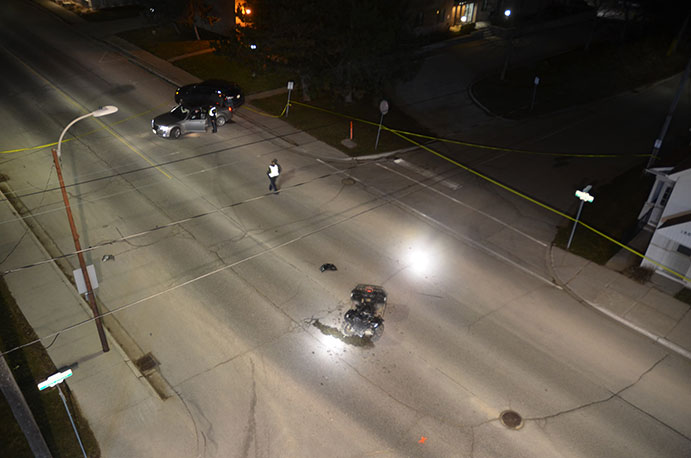
17-OVI-062 / Aerial view of collision scene
Director's Decision (Summary from Director’s Report)
The question to be determined is whether or not there are reasonable grounds to believe that the SO committed a criminal offence, specifically, whether or not his driving rose to the level of being dangerous, and therefore in contravention of s.249(1) of the Criminal Code, and whether it caused bodily harm contrary to s.249(3). I must consider if the SO’s driving was a marked departure from the standard of care that a reasonable person in his circumstances would observe. Since, on the evidence before me, I have reasonable grounds to believe that the SO was involved in a vehicle pursuit with an ATV, which is strictly forbidden pursuant to the HPS General Order unless he had reasonable grounds to believe that death or serious bodily harm was imminent, and that he failed to contact a supervisor before initiating or continuing the pursuit, and that he failed to reassess the situation and determine that to continue driving at those excessive speeds, in a residential area with pedestrian and vehicular traffic, on a dark night with insufficient artificial lighting, while pursuing an ATV that did not have headlamps, I undoubtedly have reasonable grounds to believe that the SO’s pursuit of the ATV contravened both the provincial Suspect Apprehension Pursuits legislation and the HPS policy.
However, a breach of the above does not necessarily equate with it being “a marked departure from the standard of care that a reasonable person would observe in the accused’s circumstances. While the pursuit was carried out on municipal roads and in a residential area, and the man’s ever increasing speeds appeared to be in direct correlation to his desire to evade police, I find that ultimately it was the voluntary decision of the man to try to outrun police and, in doing so, he fled at a dangerous rate of speed with no regard for other people using the highway, he disobeyed a stop sign at the intersection of 6th Avenue and 10th Street, and he ultimately was the cause of the collision which caused his injuries.
I hope that in summarizing the SO’s driving above I have adequately conveyed my strong disapproval of his actions, not only in initiating a pursuit of an ATV on the streets of the Town of Hanover in the first instance, which is directly prohibited by the HPS policy with respect to suspect apprehension pursuits, but also in attaining the speeds that he did in attempting to stop the man in order to investigate him for infractions of the town by-laws and an equipment infraction of the HTA. I find however, that the evidence falls short of that required to satisfy me that I have reasonable grounds to believe that the SO ran afoul of the Criminal Code or that his driving rose to the level required to meet the necessary elements for dangerous driving.
While I find, with some hesitancy, that I lack those grounds, I do so for the following reasons:
- There is no evidence that the SO, at any time, disobeyed any traffic controls, with the evidence of a witness specifically indicating that the SO took the turn from 13th Street onto 6th Avenue in a controlled manner and at a speed which she estimated at being in the area of 40 km/h. This evidence is specifically confirmed by the GPS data wherein the SO’s vehicle is clocked travelling at 40 km/h just south of that intersection;
- There is no evidence that vehicular traffic was ever interfered with, or obstructed by, the driving of the SO;
- The evidence of a witness that he observed the SO’s vehicle as having slowed to approximately 10 to 15 km/h as he approached the intersection of 6th Avenue and 10th Street, which is confirmed by the GPS data presumably taken just prior to that observation, which clocked the SO as already having reduced his speed to 28 km/h;
- The evidence of a witness that the ATV then ran the stop sign, without stopping at the intersection of 6th Avenue and 10th Street, while the SO did not;
- The evidence that the high speeds of the SO’s vehicle, as observed by multiple witnesses, as he was travelling southbound on 6th Avenue, lasted no more than a mere matter of seconds, at which point, I surmise from the officer’s slowing of his vehicle, that the SO reconsidered his options and chose to discontinue the ill-considered pursuit and he drastically reduced his speed. This evidence is positively confirmed by the GPS data, wherein the speed of the cruiser is registered at 40 km/h just south of 13th Street, and is registered again just north of 10th street as having been significantly reduced to 28 km/h. I take from this evidence that the SO, either in order to discontinue the pursuit, or knowing that a traffic controlled intersection was ahead, opted to give up on his pursuit in favour of public safety, and he significantly reduced the speed of his motor vehicle;
- In all, the SO’s lapse of judgment appears to have lasted no more than approximately ten seconds and no more than, at most, 300 metres;
- While the SO failed to notify the dispatcher that he was in a vehicular pursuit, I take into consideration that there is some evidence that the SO was unable to make contact with the dispatcher, due to heavy air traffic; and, finally
- It was the voluntary choice of the man to operate the ATV in the dangerous fashion that he did, without the aid of headlamps, in a poorly lit area, at high speeds, in order to evade police, and he is ultimately responsible for the subsequent collision for which he has paid an extremely high price. As such, I am unable to establish a causal connection between the actions of the SO, who slowed for the intersection at 6th Avenue and 10th Street, and the injuries to the man, who continued on into the intersection, after failing to stop at the stop sign, and unfortunately colliding with another vehicle.
Non-Charge: 17-OFD-135
The full report for this investigation can be found at https://www.ontario.ca/page/siu-directors-report-case-17-ofd-135. The report includes details on the evidence collected, as well as the full analysis of the investigation.Incident Narrative
In the early morning hours of Saturday, June 3, 2017, a group of persons exited a nightclub/restaurant on Clarence Street in the City of Ottawa, and became involved in an altercation with a lone male. This altercation moved down Dalhousie Street toward Murray Street. Shortly afterwards, the lone male was observed to draw a firearm and shoot one of the males from the group that had exited from the restaurant. Following the shooting, friends of the man who had been shot began to pursue the shooter. At this time, the subject officer (SO) was driving a fully marked Ottawa Police Service (OPS) vehicle patrolling Ottawa’s Byward Market Area. Upon hearing the sound of a single gunshot in the vicinity of Dalhousie and Murray Streets, the SO exited his vehicle and looked toward the direction of Dalhousie Street, where he observed a group of males chasing another man (herein to be referred to as the “Complainant”) on foot northbound on Dalhousie Street, moving westbound onto Murray Street. The SO returned to his police vehicle and made a U-turn to drive westbound on Murray Street, which is an eastbound one way street, in order to catch up to the Complainant. As the SO passed the group of males, one of the males pointed at the Complainant and shouted, “It was him,” indicating to the SO that the Complainant had fired the single gunshot on Dalhousie Street.
The SO pulled alongside the Complainant, drew his service pistol, and tried to effect a gunpoint arrest of the Complainant from inside his police vehicle. The SO ordered the Complainant to stop, but he refused to comply. The SO began pursuing the Complainant on foot eastbound on Murray Street, to a municipal parking garage located near 137 Murray Street.
The SO heard another single gunshot. As the SO entered the parking garage, one of the males who had been pursuing the shooter stumbled out of the parking garage clutching his chest. He also had been shot. The SO saw the Complainant running up a ramp southbound toward section 3 of the parking garage.
The SO continued to pursue the Complainant inside the parking garage, with his service pistol drawn, as he continuously shouted at the Complainant to stop and to get down on the ground. The Complainant suddenly turned and pointed his firearm at the SO. The SO discharged nine shots from his service pistol. The Complainant went down in between two parked cars. The SO was not sure if any of the shots had struck the Complainant. The SO maintained his position behind a concrete pillar while he waited for other police units to arrive.
Other police officers arrived and the Complainant was found between the parked cars, bleeding from an apparent gunshot wound to the head. The Coroner pronounced the Complainant dead at the scene. A subsequent post-mortem examination determined the cause of death to be as a result of a single gunshot wound to the head.
The male who was shot outside the restaurant was transported to hospital and was treated; he survived his injuries.
The man who had stumbled out of the parking garage was transported to hospital where he was pronounced dead at 3:13 a.m.
The Investigation
The SIU assigned seven investigators and two forensic investigators to probe the circumstances of this incident. The SIU interviewed six civilian witnesses and four witness officers. The subject officer participated in an SIU interview and provided a copy of his duty notes.
The Unit’s investigation included the review of the Pathologist’s conclusion, analysis of involved firearms and review of communications recordings and City of Ottawa CCTV Video Footage.
Upon request, the SIU obtained and reviewed the following materials and documents from the OPS:
- Recordings of 911 calls,
- Police Transmission Recordings,
- CPIC Query-the Complainant,
- General Occurrence Report,
- ICAD,
- Notes of witness and subject officer,
- Police Firearms Acquired – CFP,
- Procedure 6.07-Use of Force, and
- Written Statements of witnesses, and the SO.
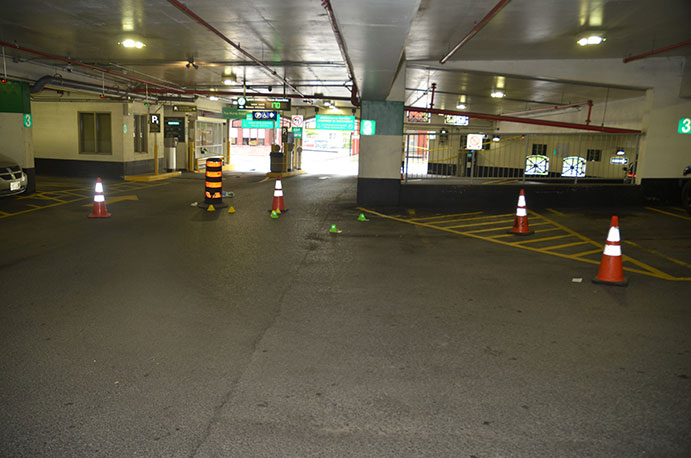
17-OFD-135 / Markers in parking garage depicting evidence locations
Director's Decision (Summary from Director’s Report)
Pursuant to s. 25(1) of the Criminal Code of Canada, a police officer, if he acts on reasonable grounds, is justified in using as much force as is necessary in the execution of a lawful duty. Further, pursuant to s. 25(3):… a person is not justified for the purposes of subsection (1) in using force that is intended or is likely to cause death or grievous bodily harm unless the person believes on reasonable grounds that it is necessary for the self-preservation of the person … from death or grievous bodily harm.
As such, in order for the SO to qualify for protection from prosecution under s. 25, it must be established that he was in the execution of a lawful duty, that he was acting on reasonable grounds, and that he used no more force than was necessary. Furthermore, pursuant to subsection 3, since death was caused, it must also be established that the SO used lethal force believing on reasonable grounds that it was necessary to do so in order to preserve himself or others from death or grievous bodily harm.
Turning first to the lawfulness of the Complainant’s apprehension, it is clear from the gunshot heard by the SO, along with the utterances yelled by the males pursuing the Complainant (in which they indicated that he was the person responsible), and the SO’s own observations of the shooting of a man, which followed almost immediately upon the Complainant entering the underground garage and pointing his firearm at the SO that the SO, at the very least, had reasonable grounds to believe that the Complainant was guilty of possession of a restricted or prohibited weapon, weapons dangerous, assault with a weapon, and attempt murder, along with a slew of other charges. As such, the pursuit and apprehension of the Complainant was legally justified in the circumstances.
It is clear from the statement of the SO that he believed that he was at risk of death or grievous bodily harm at the time that he discharged his firearm. He based that belief on his observations that the Complainant had already allegedly shot two other men and was now pointing his firearm directly at the SO. The SO indicated in his statement that there was no doubt in his mind that the Complainant was prepared to kill him. On this evidence, and based on the information in the possession of the SO at the time, it is clear that he had reasonable grounds to believe that he was at risk of death or grievous bodily harm from the Complainant at the time that he discharged his firearm and given the totality of the circumstances that his belief was objectively reasonable in the circumstances.
With respect to the other requirements pursuant to s.25 (1) and (3), I am mindful of the state of the law as set out by the Supreme Court of Canada in R. v. Nasogaluak, [2010] 1 S.C.R. 206, as follows:
Police actions should not be judged against a standard of perfection. It must be remembered that the police engage in dangerous and demanding work and often have to react quickly to emergencies. Their actions should be judged in light of these exigent circumstances. As Anderson J.A. explained in R. v. Bottrell (1981), 60 C.C.C. (2d) 211 (B.C.C.A.):In determining whether the amount of force used by the officer was necessary the jury must have regard to the circumstances as they existed at the time the force was used. They should have been directed that the appellant could not be expected to measure the force used with exactitude. [p. 218]
The court describes the test required under s.25 as follows:
Section 25(1) essentially provides that a police officer is justified in using force to effect a lawful arrest, provided that he or she acted on reasonable and probable grounds and used only as much force as was necessary in the circumstances. That is not the end of the matter. Section 25(3) also prohibits a police officer from using a greater degree of force, i.e. that which is intended or likely to cause death or grievous bodily harm, unless he or she believes that it is necessary to protect him- or herself, or another person under his or her protection, from death or grievous bodily harm. The officer's belief must be objectively reasonable. This means that the use of force under s. 25(3) is to be judged on a subjective-objective basis (Chartier v. Greaves, [2001] O.J. No. 634 (QL) (S.C.J.), at para. 59).On the basis of the foregoing principles of law then, I must determine whether the SO:
- Reasonably believed that he was at risk of death or grievous bodily harm from the Complainant at the time that he discharged his firearm; and
- Whether that belief was objectively reasonable, or, in other words, whether his actions would be considered reasonable by an objective bystander who had all of the information available to the SO at the time that he discharged his firearm.
With respect to both of these criteria, it is clear from the statement of the SO that he believed that he was at risk of death or grievous bodily harm at the time that he discharged his firearm. He based that belief on his observations that the Complainant had already allegedly shot two other men and was now pointing his firearm directly at the SO. The SO indicated in his statement that there was no doubt in his mind that the Complainant was prepared to kill him. On this evidence, and based on the information in the possession of the SO at the time, it is clear that he had reasonable grounds to believe that he was at risk of death or grievous bodily harm from the Complainant at the time that he discharged his firearm and given the totality of the circumstances that his belief was objectively reasonable in the circumstances.
On a review of all of the evidence, it is clear that the Complainant, who is observed on video to shoot the man in the parking garage and who it was believed, based on information received by the SO, had fired his gun once earlier that evening, had both the ability and the willingness to fire his weapon and was not reluctant to do so. On that basis, when he turned and pointed his firearm at the SO, the SO had no reasonable option other than to fire at the Complainant in order to save his own life; no other use of force option at his disposal would have had the ability to save his life in these circumstances.
I find in all of the circumstances that the SO reasonably believed that his life was in danger from the Complainant and thus he was justified in the use of lethal force. I find that it would have been foolish and reckless for the SO to risk his own life by waiting to see if the Complainant would actually fire upon him, when it was clear that he had already fired on one man, if not two men, in the preceding minutes; and I find that risk was not one that the SO ought to have had to take when faced with a possible life or death situation with a man who, by all appearances, was armed and was an imminent danger to the SO and perhaps other individuals in the vicinity.
I find, therefore, on this record, that the shots that were fired, one of which struck and killed the Complainant, were justified pursuant to s.25(1) and (3) of the Criminal Code and that the SO, in preserving himself from death or grievous bodily harm from the Complainant, used no more force than was necessary to effect his lawful purpose. As such, I am therefore satisfied on reasonable grounds that the actions exercised by the SO fell within the limits prescribed by the criminal law and there are no grounds for proceeding with criminal charges in this case.
Statistically Speaking
Cases opened by the SIU
During the 2017 calendar year, 380 cases were opened by the Unit, representing an increase of approximately 14% from the number of occurrences in the 2016 calendar year, when there were 327 cases.

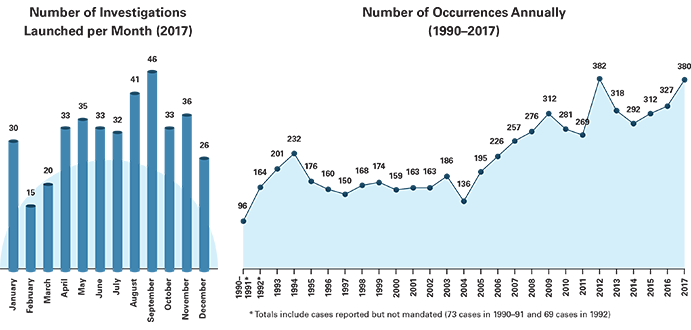
| Occurrences | '92* | '93 | '94 | '95 | '96 | '97 | '98 | '98 | '99 | '00 | '01 | '02 | '03 | '04 | '05 | '06 | '07 | '08 | '09 | '10 | '11 | '12 | '13 | '14 | '15 | '16 | '17 |
|---|---|---|---|---|---|---|---|---|---|---|---|---|---|---|---|---|---|---|---|---|---|---|---|---|---|---|---|
| Firearm Injuries | 15 | 12 | 13 | 9 | 18 | 9 | 12 | 9 | 9 | 9 | 4 | 11 | 8 | 3 | 8 | 10 | 15 | 8 | 9 | 8 | 14 | 8 | 10 | 3 | 8 | 7 | 5 |
| Firearm Deaths | 7 | 8 | 2 | 3 | 2 | 7 | 8 | 1 | 2 | 5 | 4 | 3 | 1 | 8 | 6 | 7 | 7 | 4 | 7 | 9 | 6 | 7 | 9 | 5 | 7 | 7 | 6 |
| Custody Injuries | 10 | 13 | 73 | 99 | 68 | 43 | 48 | 53 | 70 | 71 | 78 | 86 | 82 | 57 | 106 | 123 | 127 | 160 | 184 | 171 | 142 | 229 | 194 | 169 | 188 | 197 | 229 |
| Custody Deaths | 6 | 14 | 14 | 11 | 20 | 27 | 11 | 21 | 20 | 16 | 22 | 15 | 26 | 16 | 22 | 31 | 28 | 26 | 19 | 21 | 21 | 32 | 17 | 19 | 27 | 25 | 19 |
| Vehicle Injuries | 29 | 13 | 73 | 89 | 52 | 59 | 54 | 63 | 49 | 34 | 31 | 26 | 33 | 30 | 29 | 21 | 34 | 33 | 54 | 27 | 27 | 44 | 39 | 37 | 37 | 37 | 42 |
| Vehicle Deaths | 6 | 5 | 11 | 12 | 6 | 7 | 8 | 10 | 14 | 7 | 11 | 10 | 8 | 8 | 10 | 5 | 10 | 5 | 7 | 6 | 6 | 9 | 7 | 10 | 4 | 8 | 3 |
| Sexual Assault Allegations | 0 | 4 | 15 | 9 | 10 | 8 | 9 | 11 | 10 | 15 | 11 | 10 | 18 | 12 | 14 | 29 | 36 | 37 | 29 | 37 | 53 | 49 | 39 | 43 | 40 | 43 | 68 |
| Other | 0 | 0 | 0 | 0 | 0 | 0 | 0 | 0 | 0 | 2 | 2 | 2 | 0 | 2 | 0 | 0 | 0 | 3 | 3 | 2 | 0 | 4 | 3 | 6 | 1 | 3 | 8 |
| Totals | 96 | 164 | 201 | 232 | 176 | 160 | 150 | 168 | 174 | 159 | 163 | 163 | 186 | 136 | 195 | 226 | 257 | 276 | 312 | 281 | 269 | 382 | 318 | 292 | 312 | 327 | 380 |
* Totals include cases reported but not mandated (73 cases in 1990–91 and 69 cases in 1992)
How the SIU is Notified
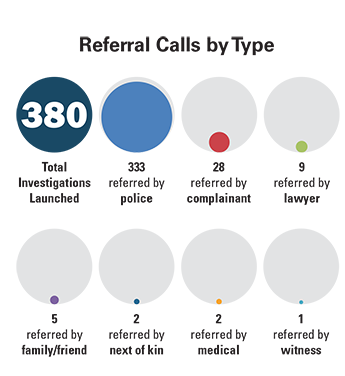
Cases Closed by the SIU
From January 1, 2017 to December 31, 2017, the SIU closed 367 cases. The number of closed cases includes occurrences from the previous year that were closed in 2017 and does not include cases that remained open at the end of 2017. The average number of days to close all cases was 167.12 days. The SIU incorporates a practice of “stop-restart dates” to calculate the length of its cases from start to finish. There are times during the course of certain cases where the SIU investigation is on hold pending some action of a third party over which the SIU has no control. This sometimes happens, for example, where an outside expert has been retained to provide an opinion regarding physical evidence and the investigation cannot proceed further until the expert’s opinion has been received. In this case, a “stop date” is designated when the expert is retained and a “restart date” is designated when the opinion is received, and that interval of time is excluded from the overall length of the case. By subtracting periods of time during which an investigation is on hold pending some action by a third party, the data more accurately reflects the relationship between SIU resources, which it controls, and the length of the cases it pursues.Cases Closed with No Reasonable Grounds to Lay Charges
In the majority of cases investigated by the SIU, the Director concluded there was no criminal wrongdoing on the part of the officers, and hence, no charges were laid. Based on the facts of the investigation, the finding was that the officers were acting within the confines of the law. In 2017, 228 investigations ended in this manner.Cases Closed by Memo
Of the 367 cases closed in 2017, 121 were closed by memo, accounting for 33% of the total number of cases. In some SIU cases, information is gathered at an early stage of the investigation which establishes that the incident, at first believed to fall within the SIU’s jurisdiction, is in fact not one that the Unit can investigate. It may be that the injury in question, upon closer scrutiny, is not in fact a “serious injury” according to the definition of serious injury that the SIU has established. In other cases, although the incident falls within the SIU’s jurisdiction, it becomes clear that there is patently nothing to investigate. Examples of such incidents include investigations in which it becomes evident early on that the injury was not directly or indirectly caused by the actions of a police officer. In these instances, the SIU Director exercises his/her discretion and “terminates” all further SIU involvement, filing a memo to that effect with the Deputy Attorney General. When this occurs, the Director does not render a decision as to whether a criminal charge is warranted in the case or not. Other law enforcement agencies may be able to deal with these incidents. Charge Cases
Criminal charges were laid by the SIU Director in 18 cases, against a total of 20 officers, accounting for 4.9% of the 367 cases that were closed in 2017. These charge cases included investigations that were launched in prior years, but for which charges were laid in 2017.Information about Complainants

Investigative Response
To assist in understanding the required investigative response in an SIU incident, the SIU tracks the time it takes for investigators to respond to an incident, and the number of investigators deployed to a scene. Speed of response and the number of investigators initially dispatched to an incident are important in many cases because of the need to secure physical evidence and to meet with witnesses before they leave the scene.
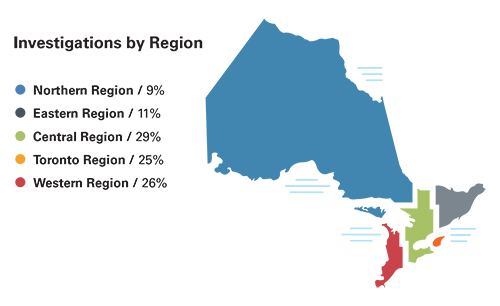
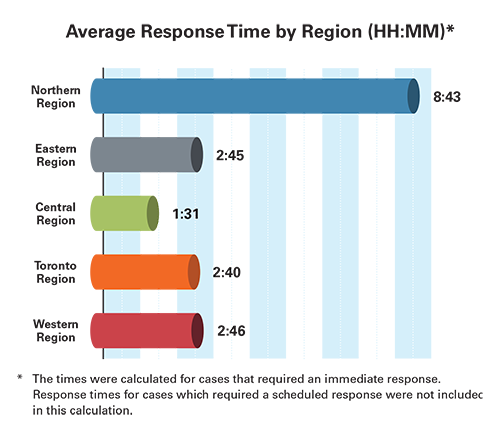
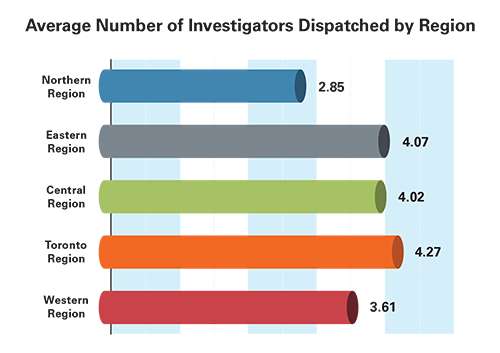
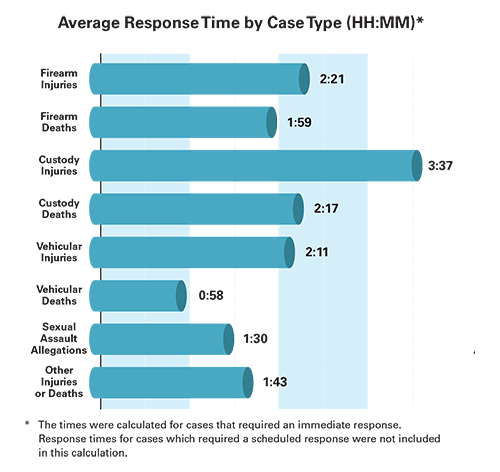
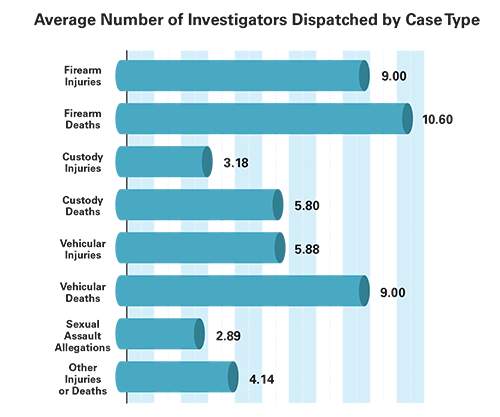
Appendix A: 2017 Case Breakdown by County, Police Service and Population
2017 SIU Case Breakdown By County, Police Service And Population
| County | Population | Police Service | Total Cases | % of Total | Firearm Injuries | Firearm Deaths | Custody Injuries | Custody Deaths | Vehicle Injuries | Vehicle Deaths | Sexual Assault Allegations | Other |
|---|---|---|---|---|---|---|---|---|---|---|---|---|
| Algoma | 115,870 | Sault Ste. Marie Police Service | 2 | 0.5% | 2 | |||||||
| OPP East Algoma Detachment | 0 | 0% | ||||||||||
| OPP Elliot Lake Detachment | 1 | 0.3% | 1 | |||||||||
| OPP Sault Ste. Marie Detachment | 0 | 0% | ||||||||||
| OPP White River Detachment | 0 | 0% | ||||||||||
| Cochrane | 81,122 | OPP Cochrane Detachment | 1 | 0.3% | 1 | |||||||
| OPP Iroquois Falls Detachment | 0 | 0% | ||||||||||
| OPP James Bay (Hearst) | 0 | 0% | ||||||||||
| OPP Kapuskasing Detachment | 0 | 0% | ||||||||||
| OPP Moosonee Detachment | 0 | 0% | ||||||||||
| OPP South Porcupine Detachment | 1 | 0.3% | 1 | |||||||||
| Timmins Police Service | 2 | 0.5% | 2 | 1 | 4 | |||||||
| Michipicoten Township Police Service | 0 | 0% | ||||||||||
| Greater Sudbury | 160,376 | Greater Sudbury Police Service | 5 | 1.3% | 4 | 1 | ||||||
| OPP Superior East (Chapleau) Detachment | 09 | 0% | ||||||||||
| Kenora | 57,607 | Dryden Police Service | 0 | 0% | ||||||||
| Kenora Police Service | 0 | 0% | ||||||||||
| OPP Dryden Detachment | 1 | 0.3% | 1 | |||||||||
| OPP Igance Detachment | 0 | 0% | ||||||||||
| OPP Dryden Detachment | 0 | 0% | ||||||||||
| OPP Kenora Detachment | 0 | 0% | ||||||||||
| OPP Pickle Lake Detachment | 1 | 0.3% | 1 | |||||||||
| OPP Red Lake Detachment | 0 | 0% | ||||||||||
| OPP Sioux Lookout Detachment | 6 | 1.6% | 5 | 1 | ||||||||
| Manitoulin | 13,048 | OPP Manitoulin Detachment | 0 | 0% | 1 | |||||||
| Muskoka | 58,047 | OPP Bracebridge Detachment | 0 | 0% | 1 | |||||||
| OPP Huntsville Detachment | 0 | 0% | 1 | |||||||||
| Nipissing | 84,736 | North Bay Police Service | 2 | 0.5% | 1 | 1 | ||||||
| West Nipissing Police Service | 2 | 0.5% | 2 | |||||||||
| OPP Mattawa Detachment | 0 | 0% | ||||||||||
| OPP North East HQ (North Bay) | 1 | 0.3% | 1 | |||||||||
| OPP North Bay Detachment | 1 | 0.3% | 1 | |||||||||
| OPP Whitney Detachment | 0 | 0% | ||||||||||
| Parry Sound | 42,162 | OPP West Parry Sound Detachment | 1 | 0.3% | 1 | |||||||
| OPP Almaguin Highlands Detachment | 0 | 0% | ||||||||||
| Rainy River | 20,370 | Atikokan Police Service | 0 | 0% | ||||||||
| OPP Rainy River District Detachment | 1 | 0.3% | 1 | |||||||||
| Sudbury | 21,196 | OPP Espanola Detachment | 2 | 0.5% | 1 | 1 | ||||||
| OPP Noelville Detachment | 0 | 0% | ||||||||||
| OPP Sudbury Detachment | 1 | 0.3% | 1 | |||||||||
| Thunder Bay | 146,057 | Thunder Bay Police Service | 3 | 0.8% | 2 | 1 | ||||||
| OPP Greenstone Detachment | 0 | 0% | ||||||||||
| OPP Marathon Detachment | 1 | 0.3% | 1 | |||||||||
| OPP Nipigon Detachment | 0 | 0% | ||||||||||
| OPP North West Region Headquarters | 0 | 0% | ||||||||||
| OPP Thunder Bay Detachment | 0 | 0% | ||||||||||
| Timiskaming | 32,634 | OPP Temiskaming Detachment | 0 | 0% | 1 | |||||||
| Temiskaming Shore Police Service | 0 | 0% | 1 | |||||||||
| TOTALS | 833,225 | % of Population: 6.5% | 35 | 9.2% | 0 | 0 | 26 | 2 | 2 | 0 | 5 | 0 |
| County | Population | Police Service | Total Cases | % of Total | Firearm Injuries | Firearm Deaths | Custody Injuries | Custody Deaths | Vehicle Injuries | Vehicle Deaths | Sexual Assault Allegations | Other |
|---|---|---|---|---|---|---|---|---|---|---|---|---|
| Frontenac | 149,738 | OPP Frontenac Detachment | 0 | 0% | ||||||||
| Kingston Police Service | 8 | 2.1% | 2 | 1 | 5 | |||||||
| Haliburton | 17,026 | OPP Haliburton Highlands Detachment | 1 | 0.3% | 1 | |||||||
| Hastings | 134,934 | Stirling-Rawdon Police Service | 0 | 0% | ||||||||
| OPP Bancroft Detachment | 2 | 0.5% | 2 | |||||||||
| OPP Central Hastings Detachment | 0 | 0% | ||||||||||
| Kawartha Lakes | 73,214 | City of Kawartha Police Service | 0 | 0% | ||||||||
| OPP City of Kawartha Lakes Detachment | 0 | 0% | ||||||||||
| Lanark | 65,667 | Smiths Falls Police Service | 0 | 0% | ||||||||
| OPP Carleton Place | 1 | 0.3% | 1 | |||||||||
| OPP Lanark County Detachment | 0 | 0% | ||||||||||
| Leeds and Grenville | 99,306 | Brockville Police Service | 0 | 0% | ||||||||
| Gananoque Police Service | 1 | 0.3% | 1 | |||||||||
| OPP Kemptville Detachment (Grenville County) | 0 | 0% | ||||||||||
| OPP Prescott Detachment (Grenville County) | 0 | 0% | ||||||||||
| OPP Leeds County Detachment | 0 | 0% | ||||||||||
| OPP Rideau Lakes Detachment | 2 | 0.5% | 1 | 1 | ||||||||
| OPP Thousand Islands Detachment | 0 | 0% | ||||||||||
| Lennox and Addington | 41,824 | OPP Napanee Detachment | 2 | 0.5% | 2 | |||||||
| Northumberland | 82,126 | Cobourg Police Service | 3 | 0.8% | 1 | 1 | 1 | |||||
| OPP Northumberland Detachment | 0 | 0% | ||||||||||
| OPP Quinte West Detachment | 1 | 0.3% | 1 | |||||||||
| Port Hope Police Service | 0 | 0% | ||||||||||
| Ottawa | 883,391 | Ottawa Police Service | 9 | 2.4% | 1 | 1 | 3 | 1 | 2 | 1 | ||
| OPP Ottawa Detachment | 0 | 0% | ||||||||||
| OPP Upper Ottawa Detachment | 0 | 0% | ||||||||||
| Peterborough | 134,933 | Peterborough-Lakefield Community Police Service | 4 | 1.1% | 4 | |||||||
| OPP Peterborough County Detachment | 1 | 0.3% | 1 | |||||||||
| Prescott and Russell | 85,381 | OPP Hawkesbury | 2 | 0.5% | 1 | 1 | ||||||
| OPP Rockland Detachment | 0 | 0% | ||||||||||
| OPP Russell County Detachment | 0 | 0% | ||||||||||
| Prince Edward | 25,258 | Belleville Police Service | 1 | 0.3% | 1 | |||||||
| OPP Prince Edward Detachment | 1 | 0.3% | 1 | |||||||||
| Renfrew | 101,326 | Pembroke Police Service | 0 | 0% | ||||||||
| OPP Arnprior Detachment | 1 | 0.3% | 1 | |||||||||
| OPP Killaloe Detachment | 1 | 0.3% | 1 | |||||||||
| OPP Pembroke Detachment | 0 | 0% | ||||||||||
| OPP Renfrew Detachment | 0 | 0% | ||||||||||
| Stormont, Dundas and Glengarry | 111,164 | OPP Alexandria Detachment | 0 | 0% | ||||||||
| Cornwall Community Police Service | 1 | 0.3% | 1 | |||||||||
| OPP Morrisburg Detachment | 1 | 0.3% | 1 | |||||||||
| OPP Stormont, Dundas & Glengarry Detachment | 0 | 0% | ||||||||||
| OPP Winchester Detachment | 0 | 0% | ||||||||||
| TOTALS | 2,005,288 | % of Population: 15.6% | 39 | 14.7% | 0 | 0 | 22 | 1 | 4 | 1 | 9 | 2 |
| County | Population | Police Service | Total Cases | % of Total | Firearm Injuries | Firearm Deaths | Custody Injuries | Custody Deaths | Vehicle Injuries | Vehicle Deaths | Sexual Assault Allegations | Other |
|---|---|---|---|---|---|---|---|---|---|---|---|---|
| Brant | 136,035 | Brantford Police Service | 1 | 0.3% | 1 | |||||||
| OPP Brant Detachment | 1 | 0.3% | 1 | |||||||||
| Dufferin | 56,881 | OPP Dufferin Detachment | 0 | 0% | ||||||||
| Orangeville Police Service | 2 | 0.5% | 1 | 1 | ||||||||
| Durham | 608,124 | Durham Regional Police Service | 12 | 3.2% | 1 | 4 | 3 | 1 | 3 | |||
| OPP Whitby Detachment | 0 | 0% | 1 | |||||||||
| Haldimand-Norfolk | 109,118 | OPP Haldimand Detachment | 1 | 0.3% | 1 | |||||||
| OPP Norfolk County Detachment | 0 | 0% | 1 | |||||||||
| Halton | 501,669 | Halton Regional Police Service | 8 | 2.1% | 5 | 2 | 1 | |||||
| OPP Burlington Detachment | 0 | 0% | ||||||||||
| Hamilton | 519,949 | Hamilton Police Service | 13 | 3.4% | 11 | 1 | 1 | |||||
| OPP Hamilton Detachment | 0 | 0% | ||||||||||
| Niagara | 431,346 | Niagara Regional Police Service | 15 | 3.9% | 11 | 1 | 2 | 1 | ||||
| OPP Niagara Detachment | 1 | 0.3% | 1 | |||||||||
| Peel | 1,296,814 | Peel Regional Police Service | 32 | 8.4% | 2 | 19 | 1 | 2 | 8 | |||
| OPP Caledon Detachment | 2 | 0.5% | 1 | 1 | ||||||||
| OPP Port Credit Detachment | 0 | 0% | ||||||||||
| Simcoe | 446,063 | Barrie Police Service | 2 | 0.5% | 1 | 1 | ||||||
| Midland Police Service | 2 | 0.5% | 1 | 1 | ||||||||
| OPP Barrie Detachment | 1 | 0.3% | 1 | |||||||||
| OPP Collingwood Detachment | 0 | 0% | ||||||||||
| OPP General Headquarters | 0 | 0% | ||||||||||
| OPP Huronia West Detachment | 2 | 0.5% | 1 | 1 | ||||||||
| OPP Nottawasaga Detachment | 0 | 0% | ||||||||||
| OPP Southern Georgian Bay Detachment | 0 | 0% | ||||||||||
| OPP Orillia Detachment | 0 | 0% | ||||||||||
| South Simcoe Police Service | 2 | 0.5% | 2 | |||||||||
| York | 1,032,524 | York Regional Police Service | 12 | 3.2% | 1 | 9 | 2 | |||||
| OPP Aurora Detachment | 1 | 0.3% | 1 | |||||||||
| TOTALS | 5,138,523 | % of Population: 39.9% | 110 | 28.9% | 1 | 3 | 68 | 3 | 12 | 1 | 19 | 3 |
| County | Population | Police Service | Total Cases | % of Total | Firearm Injuries | Firearm Deaths | Custody Injuries | Custody Deaths | Vehicle Injuries | Vehicle Deaths | Sexual Assault Allegations | Other |
|---|---|---|---|---|---|---|---|---|---|---|---|---|
| Toronto | 2,615,060 | Toronto Police Service | 92 | 24.2% | 2 | 57 | 6 | 10 | 17 | |||
| OPP Toronto Detachment | 1 | 0.3% | 1 | |||||||||
| TOTALS | 2,615,060 | % of Population: 20.3% | 93 | 24.5% | 2 | 0 | 57 | 6 | 11 | 0 | 17 | 0 |
| County | Population | Police Service | Total Cases | % of Total | Firearm Injuries | Firearm Deaths | Custody Injuries | Custody Deaths | Vehicle Injuries | Vehicle Deaths | Sexual Assault Allegations | Other |
|---|---|---|---|---|---|---|---|---|---|---|---|---|
| Bruce | 66,102 | Saugeen Shores Police Service | 0 | 0% | ||||||||
| Hanover Police Service | 1 | 0.3% | 1 | |||||||||
| OPP South Bruce Detachment | 3 | 0.8% | 2 | 1 | ||||||||
| OPP Bruce Peninsula Detachment | 0 | 0% | ||||||||||
| Chatham-Kent | 104,075 | Chatham-Kent Police Service | 4 | 1.1% | 2 | 1 | 1 | |||||
| OPP Chatham/Kent Detachment | 0 | 0% | ||||||||||
| Elgin | 87,461 | Aylmer Police Service | 0 | 0% | ||||||||
| OPP Elgin County Detachment | 3 | 0.8% | 2 | 1 | ||||||||
| St. Thomas Police Service | 4 | 1.1% | 2 | 2 | ||||||||
| Essex | 388,782 | Amherstburg Police Service | 0 | 0% | ||||||||
| Essex Police Service | 0 | 0% | ||||||||||
| LaSalle Police Service | 0 | 0% | ||||||||||
| Leamington Police Service | 2 | 0.5% | 2 | |||||||||
| Windsor Police Service | 17 | 4.5% | 15 | 1 | 1 | |||||||
| OPP Essex Detachment | 0 | 0% | ||||||||||
| OPP Essex County Detachment | 0 | 0% | ||||||||||
| OPP Lakeshore Detachment | 1 | 0.3% | 1 | |||||||||
| OPP Tecumseh Detachment | 0 | 0% | ||||||||||
| Grey | 92,568 | West Grey Police Service | 0 | 0% | ||||||||
| Owen Sound Police Service | 0 | 0% | ||||||||||
| OPP Grey County Detachment | 3 | 0.8% | 3 | |||||||||
| OPP Markdale Detachment | 1 | 0.3% | 1 | |||||||||
| Huron | 59,100 | Wingham Police Service | 0 | 0% | ||||||||
| OPP Goderich Municipal Detachment | 1 | 0.3% | 1 | |||||||||
| OPP Huron Detachment | 1 | 0.3% | 1 | |||||||||
| Lambton | 126,199 | Sarnia Police Service | 4 | 1.1% | 4 | |||||||
| OPP Lambton Detachment | 2 | 0.5% | 2 | |||||||||
| Middlesex | 439,151 | London Police Service | 12 | 3.2% | 9 | 3 | ||||||
| OPP London Detachment | 0 | 0% | ||||||||||
| OPP Middlesex Detachment | 4 | 1.1% | 3 | 1 | ||||||||
| OPP Western Region Headquarters | 0 | 0% | ||||||||||
| Strathroy-Caradoc Police Service | 0 | 0% | ||||||||||
| Oxford | 105,719 | Oxford Community Police Service | 0 | 0% | ||||||||
| OPP Oxford Detachment | 1 | 0.3% | 1 | |||||||||
| OPP Ingersoll Detachment | 1 | 0.3% | 1 | |||||||||
| Woodstock Police Service | 1 | 0.3% | 1 | |||||||||
| Perth County | 75,112 | Perth Police Service | 0 | 0% | ||||||||
| OPP Perth County Detachment | 3 | 0.8% | 3 | |||||||||
| Stratford Police Service | 2 | 0.5% | 2 | |||||||||
| Waterloo | 507,096 | Waterloo Regional Police Service | 24 | 6.3% | 1 | 8 | 2 | 3 | 1 | 9 | ||
| OPP Cambridge Detachment | 0 | 0% | ||||||||||
| Wellington | 208,360 | Guelph Police Service | 3 | 0.8% | 1 | 1 | 1 | |||||
| OPP Fergus Detachment | 0 | 0% | ||||||||||
| OPP South Wellington Operations Centre–Rockwood Detachment | 0 | 0% | ||||||||||
| OPP Wellington Detachment (Mount Forest) | 1 | 0.3% | 1 | |||||||||
| TOTALS | 2,259,725 | % of Population: 17.6% | 99 | 26.1% | 1 | 0 | 63 | 4 | 12 | 1 | 14 | 4 |
| Population | Total Cases | % of Total | Firearm Injuries | Firearm Deaths | Custody Injuries | Custody Deaths | Vehicle Injuries | Vehicle Deaths | Sexual Assault Allegations | Other | ||
|---|---|---|---|---|---|---|---|---|---|---|---|---|
| TOTAL – ALL REGIONS | 12,851,821 | (% of Ontario's population = 100%) | 380 | 100% | 5 | 6 | 229 | 19 | 42 | 3 | 68 | 8 |
Population information provided by 2016 Census Canada. Statistics Canada excludes First Nations data where enumeration was incomplete. For further information please refer to the Statistics Canada website. The total population for each region includes a population figure for counties in which no SIU cases took place, and therefore are not listed on the chart.
Inconsistencies in total percentages are due to rounding.
2017–2018 Financials
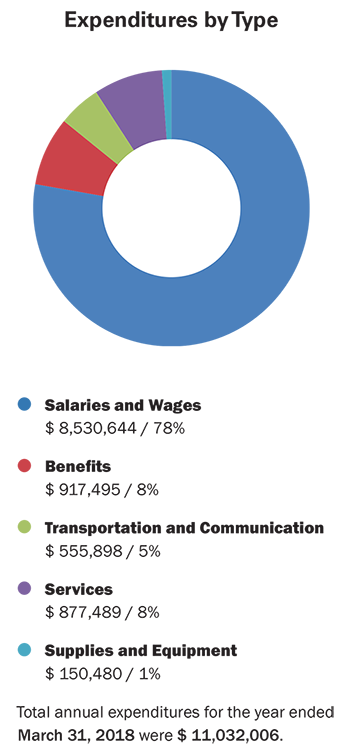
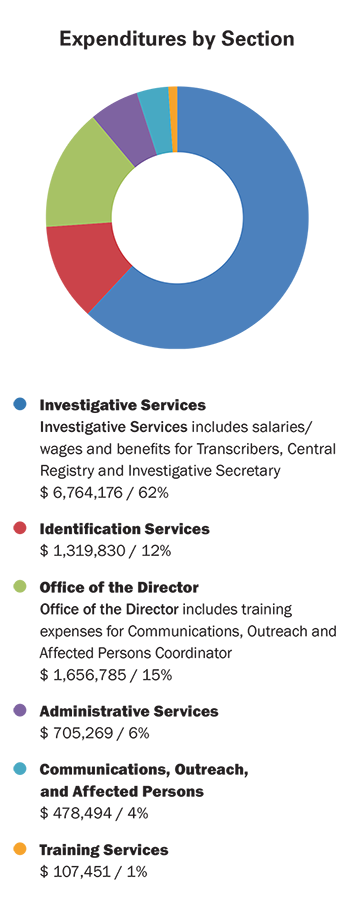

SIU Organization Chart

